Rajma Sundal:-
Kidney beans are an exceptional source of vegetarian protein and I make many dishes using it. Here are some more rajma recipes that are my number one favorites – Punjabi Rajma Masala, Kashmiri Rajma, and Dated Kidney Beans Salad. In focal and South India, Haldi Kumkum is a custom where people welcome married women to trade turmeric and vermillion. We do. In Bangalore, my companions would welcome me in the tradition, and there was always a sundal or some resemblance of it for prasad.
About Rajma Sundal:-
It is a regular dish prepared as a delicacy or side dish in practically all South Indian households. It is likewise famously served as nivedyam (prasad) during Navratri and Ganesh Chaturthi celebrations.
My recipe serves 4 people but you can increase it if you want to make it for more people.
To cook the kidney beans I used my 3-quart Minute Pot. You can also use a pressure cooker with a 3-litre burner.
You can prepare this recipe without much hassle. I cook kidney beans in advance and grind coconut. Cooked kidney beans remain good for 4-5 days in the cooler and ground coconut can be stored for 3-4 months.
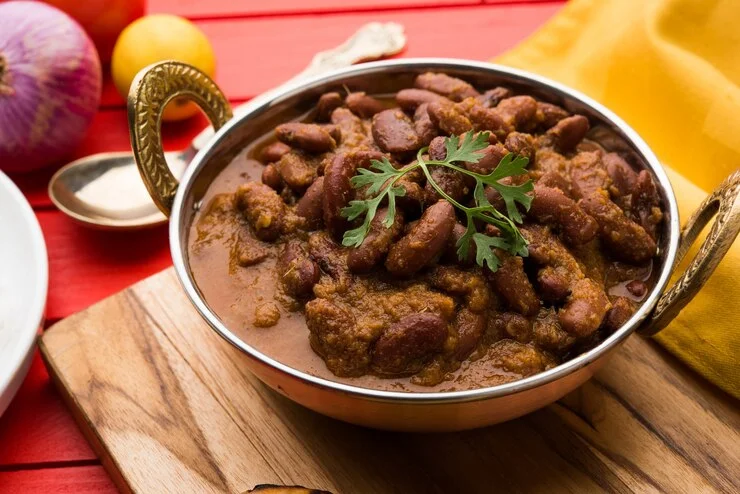
Instructions to make Rajma Sundal:-
cook kidney beans
Wash 1 cup of dried kidney beans and soak them in 4 cups of water for 5-6 hours.
Once again drain the water and filter the kidney beans.
Place the soaked kidney beans in a 3-quart saucepan with 2 teaspoons of salt and 3 cups of water. Blend gently using a scoop.
Presently secure the cover of the moment pot and move the valve to the fixing position.
Press the tension cook button and set the clock on high tension for 12 minutes. The Pall Pot will need 10-12 minutes to build tension before starting its clock.
When the watch stops, you will hear a prompt. Allow 10 minutes of undisturbed access to the strain at the time of pot discharge.
Now you can open the lid.
Heat 2 tablespoons oil in a pot over medium-high heat.
When the oil becomes hot, add the given ingredients to the pan for frying.
¼ teaspoon asafoetida
1 teaspoon clay colored mustard seeds
2 teaspoons white urad dal
2-3 dry red chillies
10-12 curry leaves
Fry the dal until it turns light brown. Mix frequently with a scoop.
Add the cooked kidney beans to the pan and mix well.
Presently remove the container intensely.
Finally, add the accompanying ingredients to the container and mix them with a spoon until combined.
¼ cup grated young coconut
2 tbsp chopped coriander
2 tbsp freshly squeezed lemon juice
Serve it hot.
Mint Rice:-
Pudina rice (pudina rice, pudina pulao) is a delicious South Indian dish made using rice, young mint leaves, vegetables and some flavourings. Serve it with raita for a hearty feast.
About Mint Rice:-
Peppermint is called Pudina in Hindi.
Pudina Chawal (Pudina Rice, Pudina Pulao) is an aromatic South Indian dish where rice is cooked with mint coconut gum, vegetables and a whole lot of flavour. This one-pot recipe is delicious and ready in just 30 minutes. This simple, solid and healthy rice dish is packed with vegetables, making it a perfect dinner for your loved ones. To make the flavor of mint shine further, do not add vegetables, as substituting them changes the taste a bit. Serve this vegetable loving and gluten free mint rice directly in lunch or dinner with any curry, raita, pickle or Serve with papad, or prepare in a lunch box. This recipe can be made in a dish on a burner or in an instant pot.
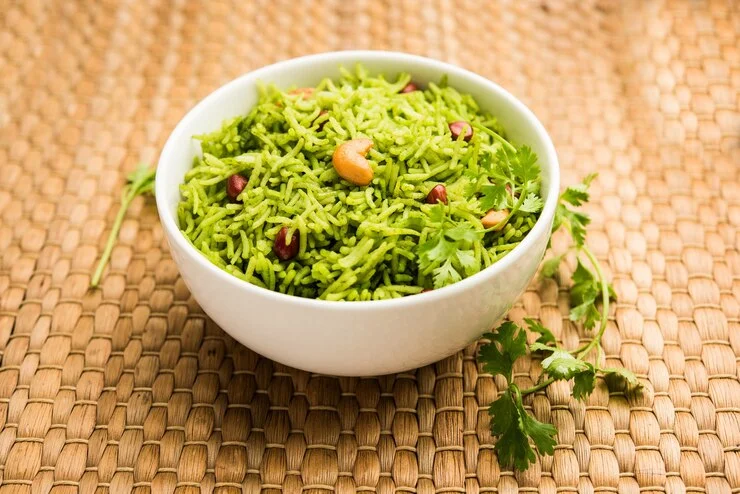
Material:-
For Mint Coconut Glue – To make the glue, you will need new mint leaves, green coriander, red onion, green chilli, new ginger, garlic, new coconut and water.
Adjust the amount of green chilies depending on how spicy you want it.
Use young coconut for best taste. If you don’t have fresh coconut, you can use desiccated coconut. Buy freshly ground coconut to save time. You will find it in the refrigerated section of the supermarket.
Rice – This dish goes well with any type of rice. Since South Indians generally use short grain Sona Masoori rice, I have also made this using the same, but go ahead and use whatever rice you have handy.
Wholesome flavor – For example, adding wholesome flavors like cumin, clove and black pepper gives a good aroma and taste to the dish.
Cashews – These are rich in protein and have a good crunch.
Vegetables – I added potatoes, carrots, green beans and green peas. You can add any vegetable of your choice. It’s also a great way to incorporate all the extra veggies you have in your refrigerator. You can vary the vegetables and make the pulao with a more noticeable mint flavour.
Oil – Use any cooking oil of your choice. For a more upscale taste, make this pulao in ghee.
Others – You will also need red onion, tomatoes and salt.
The most effective method of making mint rice:-
Make Mint Coconut Glue
Add the following ingredients to a blender.
1 cup mint leaves (crushed)
2 tbsp coriander (stuffed)
½ cup chopped red onion
1 inch piece of ginger (peeled)
5-6 whole garlic cloves (peeled)
2 teaspoons crushed green chillies
¼ cup grated young coconut
Add 2 tablespoons water and mix to make a smooth paste. put away.
Try not to add too much water while mixing; In any case, the last rice dish will be bland.
make pulao
in a dish over the burner
Rinse 1 cup white rice with water 2-3 times until the water runs clear. Add 3-4 cups of water in it and filter it.
Heat 4 tablespoons oil in a skillet over medium-high heat.
When the oil is hot, add the above ingredients and fry for 1-2 minutes until the cashews are lightly roasted, stirring regularly.
½ tsp cumin
2-3 cloves
4-5 whole black peppers
8-10 whole cashews
Add ½ cup chopped red onion and cook, stirring frequently, until they turn bright brown.
Add ¼ cup chopped tomatoes and cook for some time.
Add mint coconut gum and cook for 1 minute.
Add vegetables and cook for 2-3 minutes.
¼ cup peeled and diced potatoes (½ inch 3D squares)
¼ cup grated carrots (½ inch 3D squares)
¼ cup chopped green beans (½ inch pieces)
¼ cup green peas
Drain the rice and add 1 and 1/2 cup water and 1 teaspoon salt to the vessel and mix well.
Reduce the intensity to a minimum.
Cover the pot with a tight-fitting top. Cook without interruption until the rice becomes soft and all the water evaporates (20-25 minutes).
Remove the heat from the dish and let the rice rest for 5 minutes. Open the lid and mash the rice well with the help of a fork. serve hot!
In a Instant Pot, press the SAUTE button on the Instant Pot and follow the recipe until the rice is in the pot.
Add 1 cup water and 1 teaspoon salt and mix well.
Close the top and set the valve to the fixing position.
Press Strain Cook and set the clock on high tension for 6 minutes.
When the clock stops, allow the tension to dissipate normally for 10 minutes. Then, at that time, physically release any remaining tension and open the top.
Mash the rice and serve!
Elu Sadam (South Indian Sesame Rice):-
Alu Sadam (South Indian Sesame Rice, Till Rice) is a traditional South Indian dish prepared with rice, sesame seeds and a few additional simple ingredients. Make it using my simple recipe.
About Elu Sadam:-
Elu means “sesame” and sadam means “rice” in Tamil.
Elu sadam (sesame rice, tilled rice) is a South Indian rice preparation consisting of cooked rice mixed with newly ground powder prepared with sesame seeds and some other basic ingredients.
It is not difficult to make and is completed in less than 30 minutes.
Elu Sadam is traditionally offered to the deities on the auspicious day of Pongal (Makar Sankranti). In Tamil households, it is made on the Saturday of the auspicious Tamil month Puratasi. It is the sixth month of the Tamil schedule and is compared to approximately 15 October to 15 November of the English schedule.
You can also serve it with plain curd and papad for a casual weekday feast. It is also suitable to pack for lunch box of everyday schedule.
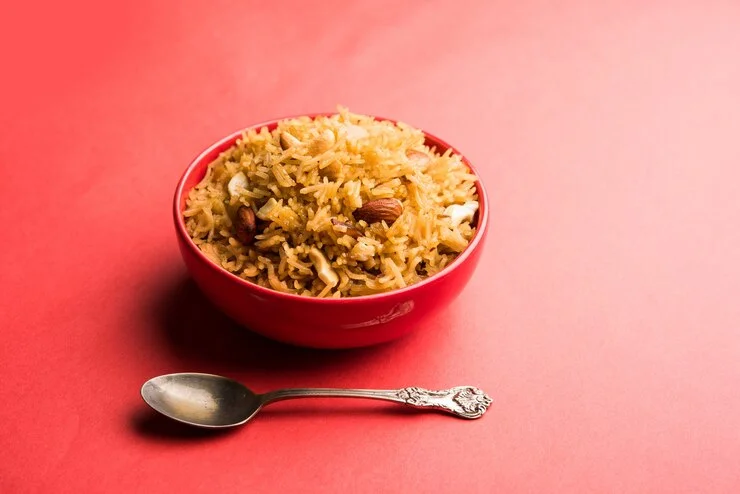
Material:-
Rice sona masoori is the preferred decision for making alu sadam. However, you can use any other white short grain, nonstick rice or basmati rice.
Cook the rice in advance and make sure it has cooled satisfactorily before pan-frying. If the rice has not cooled as expected, it becomes soggy while frying on the pan.
One day old virus rice is best for making Alu Sadam.
If you want to make it using newly cooked rice, cool it completely.
To speed up the cooling system, spread newly cooked rice on a baking plate and cover the plate with grip wrap. Place the plate in the refrigerator for 30 minutes or freeze for 15 minutes.
for sesame powder
Sesame seeds – To make rice, you will need shelled or unshelled white sesame seeds. Many people use dark sesame instead of white; You can also try it. You can also use a mixture of white and black seeds.
Fresh coconut – Use fresh coconut currently grated to save time. If fresh coconut is not available, you can also use dry coconut.
Others – You will also need chana dal (Bengal chana dal), white urad dal (peeled and cleaned black lentils), peanuts, dried red chilli and asafoetida (asafoetida).
Try not to add asafoetida to make it gluten free.
To process the rice, you will need basic ingredients, such as oil, earthy-coloured mustard seeds, cumin seeds and curry leaves.
You can use sunflower oil, canola oil, coconut oil, sesame oil, or any other oil of your choice.
The most effective method of making Alu Sadam:-
make sesame powder
Add the accompanying ingredients to a pan and cook the dish on medium-low heat until browned and fragrant, stirring as often as possible.
3 tbsp chana dal
3 tbsp white urad dal
¼ cup white sesame seeds
3 tbsp peanuts
5-6 dried red chillies (stem removed)
2 tbsp grated young coconut
Remove the dish from the pan and allow the roasted ingredients to cool completely.
Combine the boiled ingredients with ¼ teaspoon asafoetida and heartbeat in a food processor or food processor to make a fine powder.
blend the rice
Add 2 and 1/2 cups cooked and cooled rice to a large mixing bowl.
Add sesame powder and 2 teaspoons salt to the bowl and mix well to coat the rice with the powder.
temper the rice
Heat 3 tablespoons oil in a small pot over medium heat.
When the oil becomes hot, add the above ingredients and let them cook for 4-5 seconds.
½ teaspoon clay-colored mustard seeds
½ tsp cumin
10-12 curry leaves
Pour the treat over the rice and mix well.
Serve the rice cold or heat it until hot!
Vegetable Rava Upma (Sooji Upma):-
Vegetable Rava Upma (Sooji Upma, Delicious Sooji Porridge) is a famous Indian breakfast dish made using fine Sooji, onions, mild flavors and a few additional ingredients. It’s filling and nutritious and is ready in less than 20 minutes.
About Rava Upma:-
Vegetable Rava Upma (Semolina Upma) is a thick and pillowy delicious porridge made using rava (semolina, semolina), vegetables, fresh ginger, curry leaves and some additional basic ingredients.
This South Indian breakfast recipe is not difficult to make, delicious and ready in just 20 minutes.
Commonly known as Uppumavu, Uppuma, Uppindi or Uppittu, it is usually served with kesari snan (sweet semolina pudding) or coconut chutney or podi and channel espresso for regular breakfast.
It is present in the menus of South Indian homes as well as cafes, darshinis (roadside South Indian eateries), and tiffin fixates.
Traditionally, Rava Upma is made using wheat semolina (Rava), but you can make many variations using roti, vermicelli, straight rice (Poha), oats, etc.
This Indian semolina porridge is loaded with vegetables, making it nutritious, filling and healthy. You can chop the vegetables and make a straightforward version.
Overcooked upma is not sticky and is rich in flavor and taste. This dish is exceptionally easy to represent the moment of truth. Whenever made appropriately by following the recipe and estimations correctly, you can make impressive sooji upma at home, but if the estimations go wrong, it will turn into a mush.
In any case, don’t stress; My recipe will detail each step for you step by step. Just follow it and make the best rava upma ever.
This recipe can be effectively multiplied or significantly increased. Just change the ingredients; The cooking time will remain practically the same.
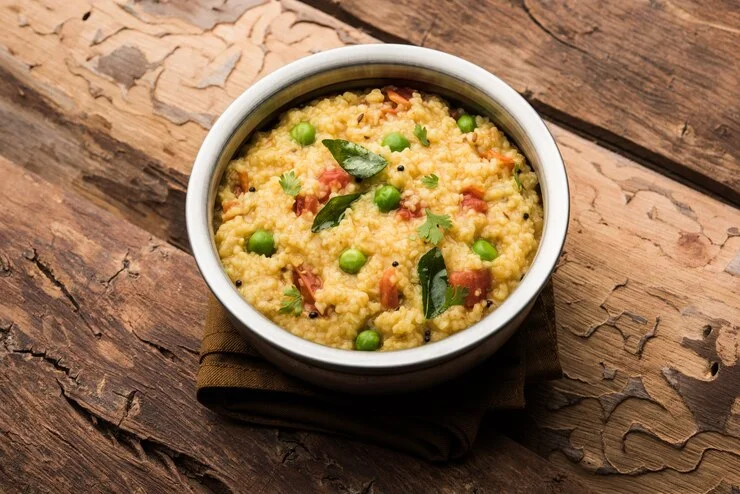
Material:-
Rava – Rava is also called semolina, cream of wheat or semolina. It comes in different thicknesses, yet always choose fine semolina or fine rava to make rava upma. It is also called Upma Rava or Bombay Rava.
Try buying boiled rava as it has a better shelf life and also reduces the cooking time in the recipe.
Ghee – You will need ghee to cook semolina. I strongly suggest using ghee (clarified spread) as it gives an extremely pleasant flavor to the final dish. Still, to create a vegetable-loving presentation, use a plant-based oil, all things considered.
For treatment – Treating the dal with earthy colored mustard, curry leaves, dry fruits and lentils gives it a pleasant taste and crispness.
Chunked and cleaned black lentils (white urad dal), Bengal gram (chana dal), and nuts like cashews or peanuts usually add a perfect mash to the delicate upma and I enthusiastically suggest including these in your recipe .
Various Ingredients – I have included red onion, green chillies, fresh ginger and vegetables in my recipe. Whatever, you can go ahead and skirt these and make an easy analogy.
I usually add carrots, green beans and peas to it, but go ahead and add broccoli, mushrooms, cauliflower, zucchini, etc.
High temperature water – The amount of water in semolina is important for the perfect surface of rava upma. I generally use 2.5 cups of boiling water per cup of semolina, which gives me perfectly soft and sticky dough every time.
Coriander and Lemon – To make it more delicious, add chopped coriander (fresh coriander leaves) at the end. Adding a little freshly squeezed lemon juice adjusts the overall flavor nicely.
The most effective method of making Rava Upma:-
Break cashews into equal parts.
Chop a little red onion and 1 small green bean stew, and grate a small piece of ginger using the small holes of the grater.
Peel one carrot and cut it into ⅛-inch pieces. Cut green beans into ⅛ inch pieces and rinse ¼ cup frozen green peas with water.
Reserve 3 cups of water for boiling in the second oven. We will need 2.5 cups of boiling water.
Gather additional materials.
cook semolina
Heat 1 teaspoon ghee in a pan on medium-low intensity.
Add 1 cup of fine semolina to the dish and mix it well with the ghee and crush the clumps with the back of the scoop.
Cook until the rava turns light brown (3-4 minutes). Keep stirring continuously so that it cooks evenly without burning the bottom of the container.
make an analogy
Wipe the same container with a paper towel to remove any rava and add the remaining ghee. Heat it on medium-high flame. When ghee is hot, add it.
1 teaspoon earthy mustard seeds,
15-20 curry leaves
1 teaspoon divided and cleaned black urad dal (white urad dal)
1 spoon bengal chana dal
8-10 chopped cashews
And fry until they turn slightly brown (1-2 minutes).
½ cup chopped red onion
2 teaspoons chopped green chillies
1 teaspoon ground ginger
Also, cook until onions turn pink (2-3 minutes). Mix as usual.
¼ cup grated carrot
¼ cup chopped green beans
¼ cup green peas
Also cook for 3-4 minutes. Mix as usual.
2.5 cups boiling water
½ teaspoon sugar
1 teaspoon salt
1 and 1/2 teaspoon freshly squeezed lemon juice
Pour into the pan and heat the mixture until it boils.
Reduce the intensity to a minimum.
Gradually add the roasted semolina and keep stirring to avoid lumps. Try to mix it well and take care that there are no lumps left in it. Ideally blend into one title.
Cover the dish from above. It is important to cover the vessel as this will cause the semolina to absorb water and become brittle.
Cook on low flame for 5-8 minutes until the semolina absorbs the water and is completely cooked.
Remove the intensity of the dish and leave it on top for 4-5 minutes.
Remove the upma from the top, mash the upma with a fork, add 1 tbsp coriander and serve hot.
Kori Roti (Kori Gassi):-
Kori Roti (Kori Gassi) is a Mangalorean-style chicken curry in which chicken is cooked with fresh boiled flavor and coconut milk. It is a fusion dish consisting of flavourful chicken curry topped with fresh rice flour bread called roti.
About Kori Roti:-
Kori Roti is a Mangalorean or Tulunadu dish, where Kori means chicken, though rotis range from thin and fresh rice wafers/arrangements.
Otherwise called Kori Gassi, chicken is cooked with relish, tamarind and coconut milk. Freshly steamed flavors enliven this waterfront curry variant, making it habit-forming. The roti is crushed on the plate and hot and delicious chicken curry is poured over it.
This chicken curry is generally eaten with roti, which is easily available in Mangalorean shops nowadays or can also be prepared at home (it requires process and work to make it). I also like to eat it with some fresh ghee broiled dosa or malabar parotta.
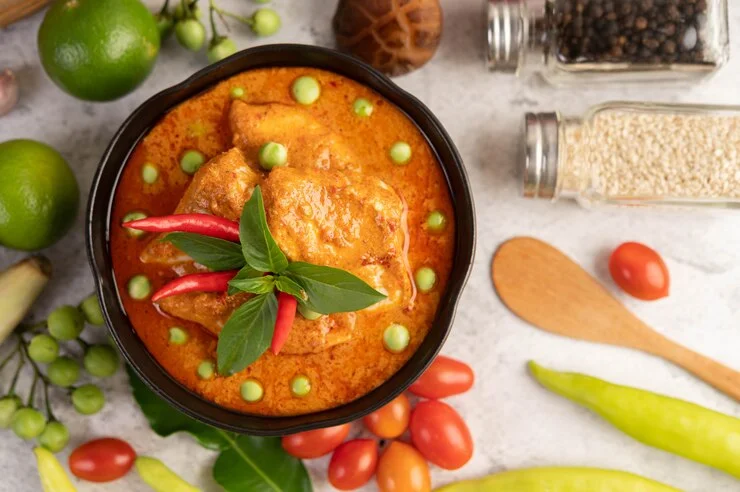
Material:-
For gum – This Mangalorean chicken curry gets a major part of its flavor from the newly made gum with the use of whole, coconut, garlic, ginger and onion.
To complete the flavour, you will need dried red chilli, coriander seeds, black pepper, fenugreek seeds and cumin. Try not to overboil the ingredients. They should be brown and not light brown. Boil on medium-low intensity and not on high intensity.
For the curry – To make this rich and velvety curry, you will need a few additional simple ingredients starting with chicken, oil, curry leaves, onion, flavor powder, tomato puree, tamarind gum and coconut milk.
For best flavor use bone-in chicken pieces, as it really absorbs the flavor pleasantly. You can also include boneless chicken in it.
Similarly, cut the curry into small pieces. Larger pieces will save some margin for cooking and the curry will also not evaporate while cooking.
For flavour, we will use only turmeric powder and garam masala powder. If you don’t have garam masala powder, just add some curry powder. For a more subtle variety, you can also include whole dry turmeric.
While locally sourced tomato puree works admirably in such a velvety and rich curry, you can always opt for locally produced tomatoes as well. Once again, tamarind gum – hand-crafted or locally purchased, the decision is yours.
Finally, you will need both good and bad coconut milk for this recipe. If you only have thick coconut milk, add a little water to it and make it delicious.
Garnish the curry with some finely chopped and fresh coriander leaves at the end.
Instructions to make Kori Gassi:-
Make Masala Gum
Heat 1 tablespoon oil in a pot over medium heat.
Add dried red chilli, coriander seeds, black pepper, fenugreek seeds, cumin, grated young coconut, garlic and ginger to the dish and the food until the flavor releases a pleasant aroma and turns light brown. Mix most of the time while cooking. Try not to overeat or overdo the flavors.
Take out the flavor in a plate and keep it aside.
Add an additional 2 tablespoons oil to a similar dish and turn on medium-high intensity.
Add finely chopped onion and cook until onion turns pink. Carefully remove the dish.
When the flavors and onions have come to room temperature, add them to the blender.
Add ½ cup water to the blender and blend to make a smooth paste.
make curry
Heat oil in a container on medium-high intensity
When the oil is hot, add curry leaves and fry for 4-5 seconds.
Add chopped onions and cook, stirring regularly, until they turn pink.
Now add turmeric powder and garam masala powder and cook for 4-5 seconds.
Add the chicken and cook for 3-4 minutes, stirring regularly.
Add ground masala gum and tomato puree and cook for some time.
Now add salt and thin coconut milk and cover the dish.
Reduce the intensity to a minimum.
Cook until chicken is tender (40-45 minutes). Mix once or twice while cooking.
Add tamarind gum and cook for 2-3 minutes.
Add thick coconut milk to it, blend it and turn off the intensity.
Garnish with finely chopped coriander and serve hot.
Ven Pongal (Khara Pongal, Ghee Pongal):-
Ven Pongal (Khara Pongal, Ghee Pongal) is a South Indian exquisite porridge made using rice and yellow moong dal. It is served as prasad in sanctuaries or made for breakfast in homes. Make this sanctuary-style protein-packed dish in a traditional pressure cooker or Instant Pot.
Pongal is an explosion of flavors inside your mouth. Black pepper, curry leaves, lots of ghee, cumin seeds, and asafoetida all come together to create a magic that is difficult to comprehend.
About Ven Pongal (Khara Pongal):-
Ven Pongal (Khara Pongal, Ghee Pongal) is a famous South Indian style exquisite porridge made using short grain rice, yellow moong dal and flavourings. It is a variety of North Indian yellow moong dal khichdi.
It is a pleasurable and consoling dish offered as naivedyam (prasadam, contribution) to divine beings in homes and sanctuaries for festivals (especially Sankranti or Pongal festival) and on auspicious days.
Apart from celebrations, it is also suitable for regular dinners, as it is light on the stomach and easy to make.
Ghee Pongal can be served for breakfast, lunch or dinner with side dishes like white coconut chutney, sambar or gotsu. I like to serve it with plain curd and papad to keep things light.
Every house in South India has its own recipe for Pongal. There is Iyengar style and Andhra style. Sanctuaries and inns have their own recipes for this dish.
The main thing that is common is the consumption of rice and yellow moong dal. However, the quantity of dal and rice may also vary from one household to another.
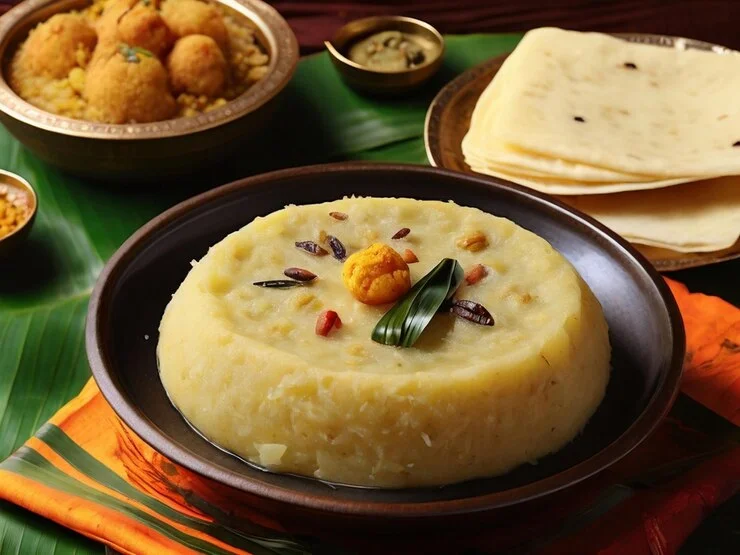
Material:-
You will find all the ingredients to make this dish in any Indian supermarket or on the web.
Rice – Traditionally, Pongal is made using newly harvested Sona Masoori rice and moong dal, which are soft and have a sticky surface. In any case, this should not dissuade you from making it with the rice and dal you have on hand.
If you don’t have gold masoori rice, use any short-grained, flavorful white rice, like jeera samba, surti kolam, or indrayani.
In an ideal world, recently harvested lentils and rice are best for making this dish as they give it a velvety surface.
Yellow Moong Dal – You will need yellow moong dal (peeled and split minor yellow lentils).
The treatment of ghee has a significant impact on the taste of Pongal. Usually cow ghee is used for its treatment, but you can also use bison ghee.
Others – You will also need asafoetida, ginger, cumin, curry leaves, green chillies, cashew nuts and black pepper.
To make it gluten free, avoid adding asafoetida to it.
You can substitute green stewed chillies as per your wish.
Cashews add an incredible mash to the delicate Pongal, so don’t skip them.
Black pepper is an undisputed necessity in this recipe. The flavor of black pepper directly improves the taste of Ven Pongal. Some people add whole black peppers to their recipes, although it is more effective if you chop one of them whole. I like to grind them coarsely in a mortar and pestle. Thus, they make Pongala extremely enjoyable without being too overwhelming.
The most effective method of making Ven Pongal:-
cook rice and dal
in the pot of a moment
Wash ½ cup yellow moong dal in water and spread it on any kitchen utensil.
Air dry for 30 minutes.
Wash ½ cup gold lentil rice and keep it aside.
Press the SAUTE button, and pour the dal into another pot.
Cook the dal, stirring occasionally, until fragrant (5-6 minutes).
Add washed rice to the cooker.
Add the given ingredients and mix well.
3 cups water
1 teaspoon salt
1 teaspoon ground ginger
Close the cover and set the valve to the fixing position.
Press Strain Cook and set the clock on high tension for 12 minutes.
When the watch stops, allow the strain to discharge normally for 10 minutes.
Remove excess tension by moving the valve to the venting position and open the cover.
Squash the pongal until somewhat velvety.
Add more water if necessary. Check the salt and add more if necessary.
Follow the recipe till you add the rice to the cooker.
Now add the above ingredients in the cooker and mix well.
4 cups water
1 teaspoon ground ginger
1 teaspoon salt
Pressure cook on high intensity till one whistle. Reduce intensity and cook for 12 minutes.
Remove the tension cooker from intensity and allow the tension to distribute normally.
Open the lid and gently crush the pongal with the back of a spoon until it becomes somewhat soft and velvety. If you feel that the mixture is too thick, add more water. It should have a porridge-like consistency.
Check the salt and add more if necessary.
make pongal tadka
Heat 3 tablespoons ghee in a small pan over medium-high heat.
When the ghee becomes hot, add the accompanying ingredients and let them cook for 4-5 seconds.
1 teaspoon cumin
¼ teaspoon asafoetida
10-12 whole curry leaves
2-3 green chillies (cut into half pieces)
10-12 coarsely ground black pepper
Add 10-12 whole cashews and fry until light brown (1-2 minutes). Keep mixing continuously while frying.
Pour the treat over the Pongal and mix well. serve hot.




